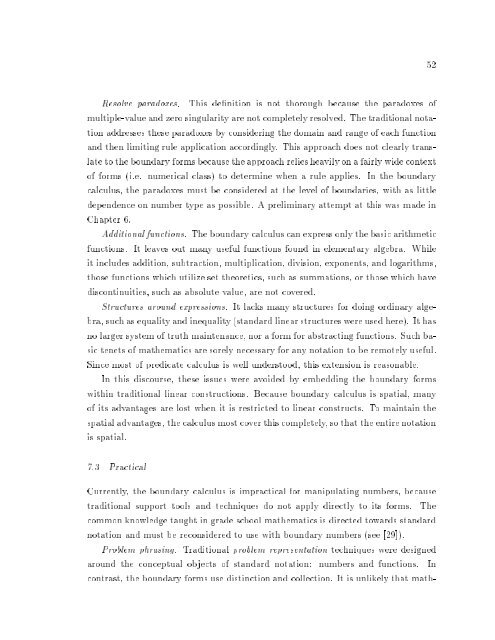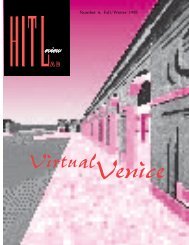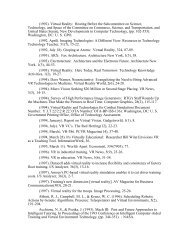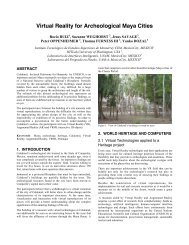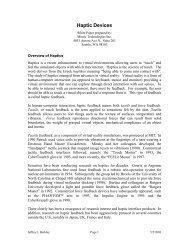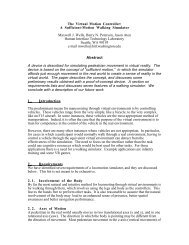A Calculus of Number Based on Spatial Forms - University of ...
A Calculus of Number Based on Spatial Forms - University of ...
A Calculus of Number Based on Spatial Forms - University of ...
You also want an ePaper? Increase the reach of your titles
YUMPU automatically turns print PDFs into web optimized ePapers that Google loves.
52<br />
Resolve paradoxes. This deniti<strong>on</strong> is not thorough because the paradoxes <str<strong>on</strong>g>of</str<strong>on</strong>g><br />
multiple-value and zero singularity are not completely resolved. The traditi<strong>on</strong>al notati<strong>on</strong><br />
addresses these paradoxes by c<strong>on</strong>sidering the domain and range <str<strong>on</strong>g>of</str<strong>on</strong>g> each functi<strong>on</strong><br />
and then limiting rule applicati<strong>on</strong> accordingly. This approach does not clearly translate<br />
to the boundary forms because the approach relies heavily <strong>on</strong> a fairly wide c<strong>on</strong>text<br />
<str<strong>on</strong>g>of</str<strong>on</strong>g> forms (i.e. numerical class) to determine when a rule applies. In the boundary<br />
calculus, the paradoxes must be c<strong>on</strong>sidered at the level <str<strong>on</strong>g>of</str<strong>on</strong>g> boundaries, with as little<br />
dependence <strong>on</strong> number type as possible. A preliminary attempt at this was made in<br />
Chapter 6.<br />
Additi<strong>on</strong>al functi<strong>on</strong>s. The boundary calculus can express <strong>on</strong>ly the basic arithmetic<br />
functi<strong>on</strong>s. It leaves out many useful functi<strong>on</strong>s found in elementary algebra. While<br />
it includes additi<strong>on</strong>, subtracti<strong>on</strong>, multiplicati<strong>on</strong>, divisi<strong>on</strong>, exp<strong>on</strong>ents, and logarithms,<br />
those functi<strong>on</strong>s which utilize set theoretics, such as summati<strong>on</strong>s, or those which have<br />
disc<strong>on</strong>tinuities, such as absolute value, are not covered.<br />
Structures around expressi<strong>on</strong>s. It lacks many structures for doing ordinary algebra,<br />
such as equality and inequality (standard linear structures were used here). It has<br />
no larger system <str<strong>on</strong>g>of</str<strong>on</strong>g> truth maintenance, nor a form for abstracting functi<strong>on</strong>s. Such basic<br />
tenets <str<strong>on</strong>g>of</str<strong>on</strong>g> mathematics are sorely necessary for any notati<strong>on</strong> to be remotely useful.<br />
Since most <str<strong>on</strong>g>of</str<strong>on</strong>g> predicate calculus is well understood, this extensi<strong>on</strong> is reas<strong>on</strong>able.<br />
In this discourse, these issues were avoided by embedding the boundary forms<br />
within traditi<strong>on</strong>al linear c<strong>on</strong>structi<strong>on</strong>s. Because boundary calculus is spatial, many<br />
<str<strong>on</strong>g>of</str<strong>on</strong>g> its advantages are lost when it is restricted to linear c<strong>on</strong>structs. To maintain the<br />
spatial advantages, the calculus most cover this completely, so that the entire notati<strong>on</strong><br />
is spatial.<br />
7.3 Practical<br />
Currently, the boundary calculus is impractical for manipulating numbers, because<br />
traditi<strong>on</strong>al support tools and techniques do not apply directly to its forms. The<br />
comm<strong>on</strong> knowledge taught in grade school mathematics is directed towards standard<br />
notati<strong>on</strong> and must be rec<strong>on</strong>sidered to use with boundary numbers (see [29]).<br />
Problem phrasing. Traditi<strong>on</strong>al problem representati<strong>on</strong> techniques were designed<br />
around the c<strong>on</strong>ceptual objects <str<strong>on</strong>g>of</str<strong>on</strong>g> standard notati<strong>on</strong>: numbers and functi<strong>on</strong>s. In<br />
c<strong>on</strong>trast, the boundary forms use distincti<strong>on</strong> and collecti<strong>on</strong>. It is unlikely that math-


